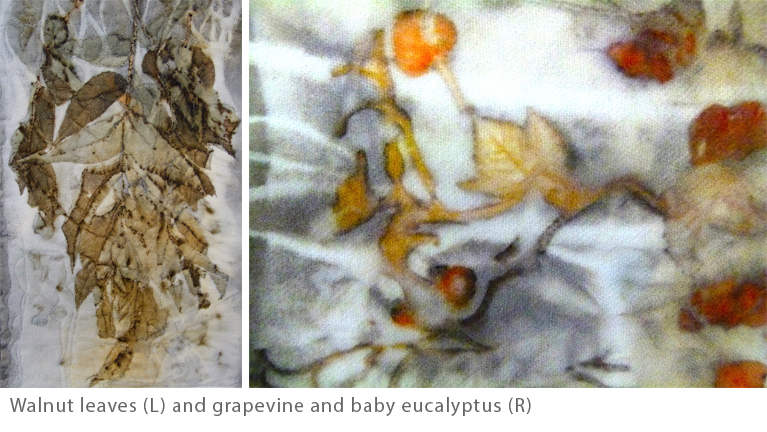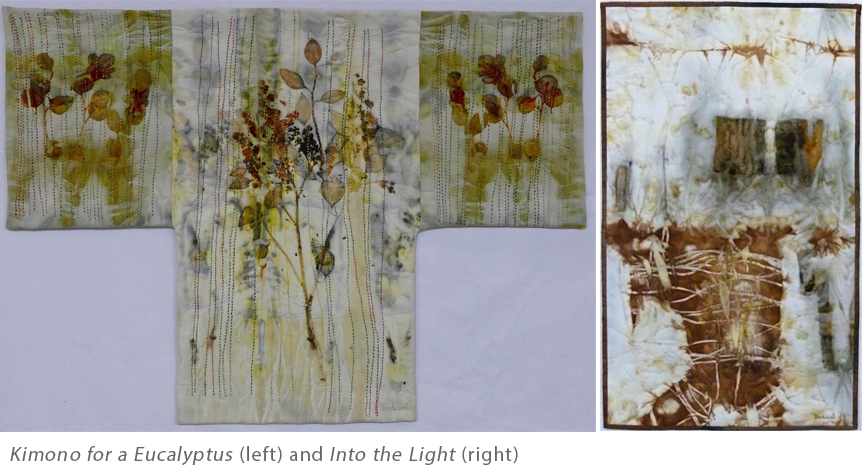Wrap and rust dyeing is a fabulous, unpredictable surface design process that uses the exciting natural pigments in specific botanical materials to create unique contact prints by wrapping fabric and plants in bundles. Unwrapping every bundle is like a Christmas surprise. I get really excited to see what the pot, fabrics, metals and plants have decided to make for me! And then I start to wonder how I will create with each piece. It is such great fun!
I’ll share my process including a few tips followed by a list of tools, supplies and the plants I use most often in my work.
I live in Southern Ontario. I use plants grown nearby or get a few from the florist. Experiment with your own local plants! Plants can be fresh or dried. My outdoor studio has large canning pots on hotplates to boil the bundles in water. I add a few tablespoons of alum to each pot and sometimes rusty objects. I fit as much as possible in the pot and keep everything underwater. I put a stone on top to weigh bundles down. I add water as necessary and always stay close to the pot. Sometimes I add plant material to the water. For example, walnuts add a grayish to dark brown color and goldenrod adds acid greenish-yellow.
I turn off the heat after a few hours of boiling and let the bundles sit in the pot for as much time as it takes to start to see the color coming through to the outside of the fabric. It could be hours or days. I often boil again. PATIENCE is a virtue. I use tongs to handle hot bundles and let them drain and cool before unwrapping.
When unwrapping, I carefully remove the plant material and metal scraps lying on the cloth to see what pigments and patterns it took in. The fabric is then hosed down and rinsed thoroughly then hung to dry. After drying, everything gets ironed to remove the boiled-in creases.
Straight rusting on cloth is another wrapping process. All fibres can be rusted. I gather rusty objects at barn and garage sales, from my local welder’s dumpster and on walks. Please handle it all very carefully! For rust dyeing, the cloth must be bundled tightly with elastics, then soaked in a strong vinegar solution for about 20 minutes. Then I leave it to cook in the sun until rusty marks show on the outside. Bundles can be put in plastic bags to accelerate the process. If it is slow, I may resoak in the vinegar solution. When unwrapped, this cloth needs to be thoroughly rinsed and soaked in water to halt the rusting process.
Now what to do with all this lovely material? Sometimes I find good bits and fix them to canvas frames. I add words that inspire me. I find pieces that go together to tell a story. I hand stitch and embroider with variegated threads. I machine quilt in patterns to follow the marks in the cloth. Sometimes I take my eco-dyed and rusty fabrics and over-dye them using a variety of chemical dyes or sometimes I add these dyes into the initial mix.
Wrap and rust dyeing is largely a process of experimentation and exploration. Because there are so many variables, it is challenging to predict and control results. Even the slightest differences in water quality, time of year, time of day, soil, seasonal changes, altitude, longitude, latitude, amount and quality of rainfall, type of pot, mordants, fabric, state of plant (dried or fresh, fallen or cut), part of plant used, amount of time immersed or boiled, plants in dye bath interacting with each other, degree of rust, actual metal content in rusty scraps, hot vs. warm vs. cold immersion, how the bundle is wrapped, size of bundle, and many other issues will completely change the imprint and colours.
We must suspend an attitude of needing to have a clear sense of the outcome before beginning and go with the flow of what you get. It is generally far more beautiful than you could have predicted! The pieces that I don’t like initially either grow on me, or they find a place as background or sideline or embroidery cloth. They can also be over-dyed for very interesting effects. Ironing and air-drying can sometimes change the look. I am not at all scientific or scholarly in my approach. It is playtime and “what if” and “oh wow” to me.
People have been using plants to colour cloth forever. I owe India Flint a debt of gratitude for her inspiration. I have been exploring these techniques and creating a body of work called “What Remains” ever since.
Tips
Use PFD linen, cotton, bamboo, silk, rug hookers’ wool and a variety of blends.
Lay the fabric out flat, arrange the botanical materials any way that pleases you on top and then roll it all up tightly. Bundles can also be folded or wrapped shibori style. Careful placement and wrapping can result in patterns that are more deliberate and controlled.
Elastics can also offer interesting resist patterns.
You can soak leaves in rusty water to lay on fabric with no other rust.
Dried plants can be reconstituted with water. Just soak or spritz them.
There is a mirroring result when you make bundles with a “plant sandwich.” Place plants on one layer of cloth, then plants and then another layer of cloth, then bundle.
To get good results on cellulose (plant-based) fibres, soak first in a milk solution. Fabric can be damp and then bundled.
Supplies and Tools
hotplate on a sturdy inflammable table, dedicated canning pot used only for dyeing, tongs, oven mitts, old towels, colourless elastics or neutral coloured string or yarn, alum (found in the spice section at the grocery store), vinegar, rubber gloves, drying rack, apron/old clothes, camera, notebook, several large metal bowls, plastic tote/plastic bags for rusting, knife and cutting board for food, lint roller to remove dead bits of leaves from fabric when dried, cedar essential oil to drip in storage bags to preserve wool from moths, Plants
Flowers:
Goldenrod, dogwood, daylilies (including stamens, all colors), campanula, catalpa pods and leaves, hibiscus flowers, periwinkle, violas, pansies, petunia, marigold, tansy flowers, Queen Ann’s lace, coral bell leaves, dahlia flowers, brown-eyed Susan flowers and leaves
Trees:
Maple leaves, birch, chestnut leaves, eucalyptus (not dyed), plum leaves, apple leaves and bark, oak leaves, weeping pussy willow leaves,
Other Plants:
Grapevines and leaves (and grapes!), walnut pods, sumac seeds and pods, elderberry leaves and fruit, strawberry leaves, stems, roots and runners, raspberry leaves, smoke bush leaves, sage leaves, ferns, corkscrew hazel leaves, beets, purple cabbage, onion skins
ABOUT THE ARTIST
 Maggie Vanderweit is from Ontario, Canada. She teaches and lectures extensively. Her work is internationally exhibited and in private collections around the world. She is a SAQA Juried Art Member and Regional Representative for the Central Canada region.
Maggie Vanderweit is from Ontario, Canada. She teaches and lectures extensively. Her work is internationally exhibited and in private collections around the world. She is a SAQA Juried Art Member and Regional Representative for the Central Canada region.
Maggie’s book Stone Threads is a retrospective of her journey as a maker. It is available for purchase on her website.




